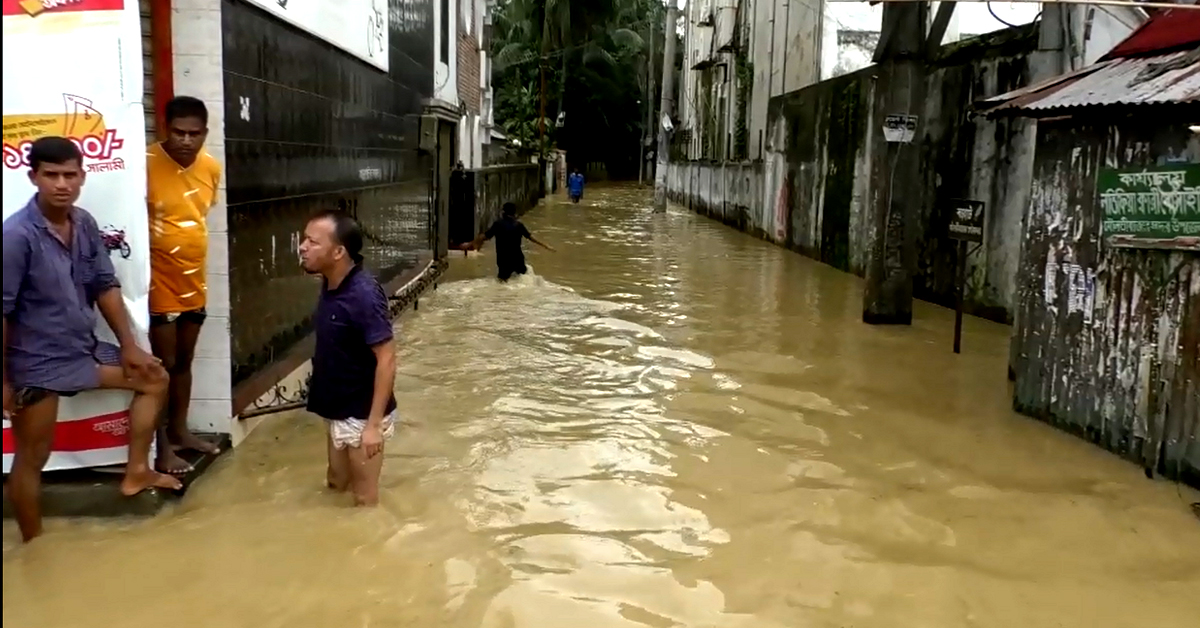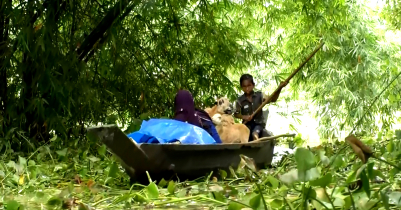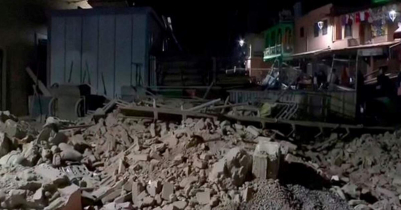Hasanat Kamal
Update: 20:24, 9 February 2025
Bangladesh’s 15 Climate Risks: A Nation on the Frontlines of the Climate Crisis

Flood-Affected Bangladesh Struggles with Rising Waters.
Bangladesh is globally recognized as one of the most climate-vulnerable nations, facing a range of environmental hazards that threaten its people, economy, and ecosystems. Due to its geographical location, dense population, and economic reliance on agriculture, the country experiences frequent natural disasters and long-term climate challenges. This article explores 15 major climate risks Bangladesh faces and their potential consequences for its future.
1. Rising Sea Levels
A significant portion of Bangladesh lies at or just above sea level, making it highly susceptible to rising sea levels caused by global warming. By 2050, it is estimated that up to 17% of Bangladesh’s coastal land could be submerged, displacing millions and severely impacting agriculture and fisheries.
2. Coastal Erosion
Bangladesh’s extensive coastline is facing increasing erosion due to stronger tidal waves, riverbank erosion, and extreme weather events. Entire communities have been forced to relocate as homes, farmland, and infrastructure are washed away.
3. Salinity Intrusion
Rising sea levels and increased cyclones are causing saltwater to infiltrate freshwater sources, rendering farmland unproductive and contaminating drinking water supplies. This has severe health implications and threatens food security.
4. Frequent and Intense Cyclones
Bangladesh is located in a cyclone-prone region, and climate change is making these storms more frequent and severe. Cyclone Sidr (2007) and Amphan (2020) are stark reminders of the devastation they bring, including loss of life, property destruction, and economic setbacks.
5. Riverbank Erosion
Many of Bangladesh’s major rivers, including the Padma, Meghna, and Jamuna, are experiencing increased erosion due to unpredictable water flow and sedimentation. Thousands of families lose their homes and land each year due to this slow but relentless process.
6. Increased Flooding
Bangladesh experiences frequent flooding, exacerbated by heavy monsoon rains, glacier melt from the Himalayas, and poor drainage systems. In 2020, floods affected over 5.4 million people, submerging large areas of cropland and disrupting livelihoods.
7. Droughts in Northern Regions
While floods affect coastal and central regions, northern Bangladesh faces increasing droughts due to erratic rainfall patterns and high temperatures. This threatens food production, particularly rice and wheat crops, leading to economic distress for farmers.
8. Extreme Heatwaves
Rising global temperatures have led to more frequent and intense heatwaves, particularly in urban areas like Dhaka. These extreme temperatures pose health risks, increase energy demand for cooling, and reduce labor productivity.
9. Water Scarcity
Climate change is affecting freshwater availability in Bangladesh. Over-extraction of groundwater, combined with pollution and erratic rainfall, is making clean drinking water scarce, particularly in arid regions and urban slums.
10. Loss of Biodiversity
The Sundarbans, the world’s largest mangrove forest and home to the Bengal tiger, is under threat due to rising sea levels, increased salinity, and deforestation. This loss of biodiversity affects both local ecosystems and global conservation efforts.
11. Air Pollution and Environmental Degradation
While not entirely climate-related, increased industrialization and deforestation contribute to worsening air quality in Bangladesh. Dhaka consistently ranks among the world’s most polluted cities, leading to respiratory diseases and other health issues.
12. Reduced Agricultural Productivity
Climate change is reducing crop yields due to increased temperatures, erratic rainfall, and soil degradation. Farmers are struggling to adapt, leading to food shortages, higher prices, and economic instability.
13. Waterborne Diseases and Public Health Risks
With increased flooding and waterlogging, Bangladesh is witnessing a rise in waterborne diseases such as cholera, dengue, and diarrhea. Poor sanitation infrastructure exacerbates the situation, particularly in rural and low-income areas.
14. Climate-Induced Migration and Urban Overcrowding
As rural communities face climate-related hardships, people are migrating to cities like Dhaka and Chattogram in search of work and stability. This has led to rapid urbanization, slum expansion, and increased pressure on resources and infrastructure.
15. Economic Vulnerability and Poverty
The cumulative effect of these climate risks is pushing more people into poverty. The loss of livelihoods, destruction of property, and increased cost of living due to climate change are making it harder for Bangladesh’s most vulnerable populations to survive and recover.
Bangladesh is at the forefront of the global climate crisis, facing multiple, interconnected risks that threaten its future. While the government and international organizations have initiated various adaptation and mitigation strategies, more action is needed. Urgent global cooperation, climate finance, and sustainable policies are essential to protect Bangladesh from the worsening impact of climate change. Only through comprehensive efforts can the country build resilience and safeguard its people and environment for generations to come.
- Dubai-bound flight catches fire after taking off from Nepal
- Turkey`s homegrown 5th-generation fighter jet named KAAN
- Shihab Chottur reaches Makkah from India in 12 months
- Eid Ul Adha 2023 in Saudi Arabia!
- Italy will take 82 thousand workers, the is in March
- World`s first 3D-printed mosque to be constructed in Dubai
- India gets new parliament building
- Karnataka: Modi invokes `The Kerala Story` to target Congress
- Imran Khan likely to be in custody for ‘4 to 5 days’
- Two Sylheti killed in Portugal






























